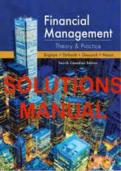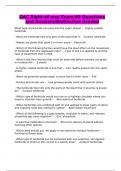,Solution Manual For
Financial Management Theory and Practice 4CE Eugene F. Brigham Michael C.
Ehrhardt Jerome Gessaroli Richard R. Nason
Chapter 1-24
Chapter 1
An Overview of Financial Management
and the Financial Environment
ANSWERS TO END-OF-CHAPTER QUESTIONS
1-1 a. A proprietorship, or sole proprietorship, is a business owned by one individual.
A partnership exists when two or more persons associate to conduct a business.
In contrast, a corporation is a legal entity created by provincial or federal laws.
The corporation is separate and distinct from its owners and managers.
b. In a limited partnership, limited partners’ liabilities, investment returns, and control
are limited, while general partners have unlimited liability and control. The primary
benefit of a limited liability partnership (LLP) is the protection it offers partners to
liability exposure from their other partners’ professional negligence. Individual
partners still maintain unlimited liability for their own negligence or negligence of
those they directly supervise. A professional corporation (PC) has most of the
benefits of incorporation but the participants are not relieved of professional
(malpractice) liability.
c. Shareholder wealth maximization is the appropriate goal for management decisions.
The risk and timing associated with expected earnings per share and cash flows are
considered in order to maximize the price of the firm’s common stock.
d. A money market is a financial market for debt securities with maturities of less than
one year (short-term). The New York money market is the world’s largest. Capital
markets are the financial markets for long-term debt and corporate stock. The New
York Stock Exchange and Toronto Stock Exchange are examples of capital markets.
Primary markets are the markets in which newly issued securities are sold for the first
time. Secondary markets are where securities are resold after initial issue in the
primary market. The New York Stock Exchange and Toronto Stock Exchange are
secondary markets.
Brigham, Financial Management, 4Ce, Solutions © 2023 Cengage Learning Canada, Inc. 1-1
, e. In private markets, transactions are worked out directly between two parties and
structured in any manner that appeals to them. Bank loans and private placements of
debt with insurance companies are examples of private market transactions. In public
markets, standardized contracts are traded on organized exchanges. Securities that are
issued in public markets, such as common stock and corporate bonds, are ultimately
held by a large number of individuals. Private market securities are more tailor-made
but less liquid, whereas public market securities are more liquid but subject to greater
standardization. Derivatives are claims whose value depends on what happens to the
value of some other asset. Futures and options are two important types of derivatives,
and their values depend on what happens to the prices of other assets, say Tim
Hortons shares, Japanese yen, or pork bellies. Therefore, the value of a derivative
security is derived from the value of an underlying real asset.
f. An investment banker is a middleman between businesses and savers. Investment
banks assist in the design of corporate securities and then sell them to savers
(investors) in the primary markets. A financial intermediary buys securities with
funds that it obtains by issuing its own securities. An example is a common stock
mutual fund that buys common shares with funds obtained by issuing shares in the
mutual fund.
g. A mutual fund is a corporation that sells shares in a fund and uses the proceeds to buy
stocks, long-term bonds, or short-term debt instruments. The resulting dividends,
interest, and capital gains are distributed to the fund’s shareholders after the
deduction of operating expenses. Different funds are designed to meet different
objectives. Money market funds are mutual funds that invest in short-term debt
instruments, typically with maturity dates of less than one year.
h. Production opportunities are the returns available within an economy from investment
in productive assets. The higher the production opportunities, the more producers
would be willing to pay for required capital. Consumption time preferences refer to
the preferred pattern of consumption. Consumers’ time preferences for consumption
establish how much consumption they are willing to defer, and hence save, at
different levels of interest.
i. A foreign trade deficit occurs when businesses and individuals in a country import
more goods from foreign countries than are exported. Trade deficits must be financed,
and the main source of financing is debt. Therefore, as the trade deficit increases, the
debt financing increases, driving up interest rates. Interest rates, however, must be
competitive with foreign interest rates; if the central bank attempts to set interest rates
lower than foreign rates, foreigners will sell bonds, decreasing bond prices, resulting
in higher rates. Thus, if the trade deficit is large relative to the size of the overall
economy, it may hinder the central bank’s ability to combat a recession by lowering
interest rates.
1-2 Sole proprietorship, partnership, and corporation are the three principal forms of business
organization. The advantages of the first two include the ease and low cost of formation.
1-2 Brigham, Financial Management, 4Ce, Solutions © 2023 Cengage Learning Canada, Inc.
, The advantages of the corporation include limited liability, indefinite life, ease of
ownership transfer, and access to capital markets.
The disadvantages of a sole proprietorship are (1) difficulty in obtaining large sums
of capital, (2) unlimited personal liability for business debts, and (3) limited life. The
disadvantages of a partnership are (1) unlimited liability, (2) limited life, (3) difficulty of
transferring ownership, and (4) difficulty of raising large amounts of capital. The
disadvantages of a corporation are (1) double taxation of earnings and (2) requirements to
file federal reports for registration, which are expensive, complex, and time consuming.
1-3 A firm’s fundamental, or intrinsic, value is the present value of its free cash flows when
discounted at the weighted average cost of capital. If the market price reflects all relevant
information, then the observed price is also the intrinsic price. If material information is
withheld from investors, the firm’s intrinsic value may differ from its actual market
value.
1-4 a. Corporate philanthropy is always a sticky issue, but it can be justified in terms of
helping to create a more attractive community that will make it easier to hire a
productive workforce. This corporate philanthropy could be received by shareholders
negatively, especially those shareholders not living in its headquarters’ city.
Shareholders are interested in actions that maximize share price, and if competing
firms are not making similar contributions, the ―cost‖ of this philanthropy has to be
borne by someone—the shareholders. Thus, the stock price could decrease.
b. Companies must make investments in the current period in order to generate future
cash flows. Shareholders should be aware of this and, assuming a correct analysis has
been performed, they should react positively to the decision. The Mexican plant is in
this category. Assuming that the correct capital budgeting analysis has been made, the
stock price should increase in the future.
1-5 Earnings per share in the current year will decline due to the cost of the investment made
in the current year and no significant performance impact in the short run. However, the
company’s intrinsic value and its share price should increase due to the significant cost
savings expected in the future.
1-6 In a well-functioning economy, capital will flow efficiently from those who supply
capital to those who demand it. This transfer of capital can take place in three different
ways:
1. Direct transfers of money and securities occur when a business sells its shares or
bonds directly to savers, without going through any type of financial institution. The
business delivers its securities to savers, who in turn give the firm the money it needs.
2. Transfers may also go through an investment banking house that underwrites the
issue. An underwriter serves as a middleman and facilitates the issuance of securities.
The company sells its stocks or bonds to the investment bank, which in turn sells
Brigham, Financial Management, 4Ce, Solutions © 2023 Cengage Learning Canada, Inc. 1-3





